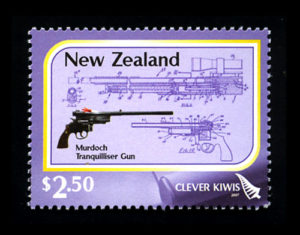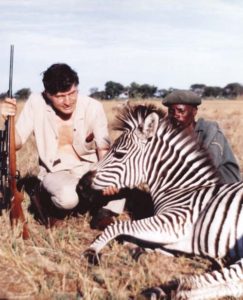It is an essential tool of wildlife conservation. It is the only effective way to collect data from living animals. It is the only safe way to capture, mark and release live animals. It is one of the first scenes in most wildlife television shows. It is the tranquilizer gun. And we owe it to pharmacist, veterinarian and inventor Colin Murdoch.

Murdoch was born on February 6, 1929, in Christchurch, New Zealand (died 2008). He wasn’t a particularly good student, hampered by dyslexia, but he was always good with his hands—he was also ambidextrous—and loved both nature and technology. He recounted that he had vivid dreams in which ideas for inventions would appear, rotating around in three-dimensions. He kept a notepad by his bed to draw out the inventions when he woke.
When he was ten, Murdoch developed a unique way to make a controlled explosion. He built a gun that used his technique, and he hunted small game with it for many years. During World War II, he gained experience repairing guns for family and neighbors, because new guns were not available. His extensive knowledge of guns would prove useful later.
He trained to become a pharmacist, following in his father’s footsteps. After World War II, New Zealand suffered from a shortage of skilled professionals, including veterinarians in a livestock-oriented country. So, Murdoch began serving other animals as well as humans—and added “veterinarian” to his professions.
He became concerned with the high rate of infections when doctors reused glass syringes—spreading the various diseases they were attempting to cure. So in 1956, he invented the disposable plastic syringe, now the standard way to give injections. He is credited with saving millions of lives for this single invention.
His work with animals, both domestic and wild, convinced him that a better way was needed to capture and restrain animals. Drawing on his knowledge of firearms and hypodermic needles, he adapted an air pistol to fire a large feathered hypodermic dart that could inject a tranquilizer into an animal without having to capture it. The dart’s velocity could be varied to match the size and distance of the animal, reducing injury to the target. Patented in 1959, the gun was an instant success and is now a standard tool of wildlife management.

Murdoch also realized that the tranquilizing drugs used at the time—curare and nicotine—often caused death of wild animals because of their excessive physiological response to being darted. So, he worked on adapting dosages to individual species and conditions, and he developed new chemicals that were safer and more effective. He also developed the strategy of introducing an antidote for the tranquilizer as soon as possible to reduce impact on the treated animal.
In all, Murdoch held more than 40 patents for his inventions and was broadly honored for his contributions. A later invention—loved and hated by us all—is the child-proof cap for medicine bottles. He was made a member of the New Zealand Order of Merit in 2000.
So, whenever you see an ear tag on a deer or watch a documentary about capturing and re-locating elephants or rhinos, give a little shout out to the man who made it possible—Colin Murdoch.
References:
Derby, Mark. 2010. Inventions, patents and trademarks—Farming inventions. Te Ara, the Encyclopedia of New Zealand. Available at: https://teara.govt.nz/en/postage-stamp/25400/murdoch-tranquilliser-gun. Accessed February 4, 2018.
Nzedge.com. Colin Murdoch—Dreamer for Millions. Available at: http://www.nzedge.com/legends/colin-murdoch/. Accessed February 4, 2018.
The Telegraph. 2008. Colin Murdoch. The Telegraph Obituaries, 13 Jun 2008. Available at: http://www.telegraph.co.uk/news/obituaries/2125667/Colin-Murdoch.html. Accessed February 4, 2018
